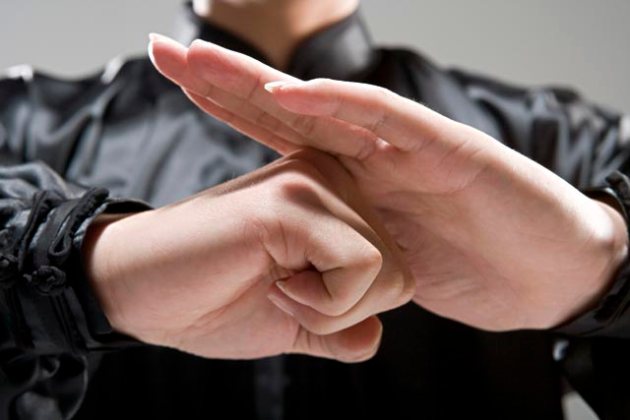In martial arts there are many different types of salutes. The wushu salute, which we perform at the beginning and at end of class, has a very deep philosophical meaning and a long cultural and ancient Chinese traditional history.
The modern wushu salute that we practice today it taken from the North Shaolin Temple Salute and it was then standardised by the people’s republic of china in 1986.
The salute was chosen due to its long history in wushu kung fu.
It is said that all Chinese Martials arts originate from Shaolin and still even hundreds of years later the Shaolin monks still maintain this high level of expertise’s of physical and spiritual attainment from there practices. It is no surprise then that the modern wushu salute today should be taken from the oldest and most honourable origin.
The hand salute is the most basic kung fu etiquette that any practitioner must understand before they begin there practice. It is a form of respect that we show when entering or leaving your place of practice, it is used to greet you master or coach and or other practitioners therefore it is very important to understand what it means.
How you do it?
- The right hand is clenched in a fist.
- The left hand thumb is bent, and the four fingers are stacked and straight.
- The palm of the left hand is placed over the fist.
- Both fist and palm are about 20 to 30 cm from the chest, with both elbows bent and the arms forming a circle.
- The hands are held at chest height.
- The feet are together with the knees straight.
- The posture is erect and the eyes are focused on the person who is being saluted.
What does it represent?
- The fist represents martial arts ability and using the right fist demonstrates that you are pledged to the cultivation of the martial arts, and are using martial arts to make friends.
- The left hand thumb is bent out of humility. Chinese people will point to themselves with their thumb instead of their index finger, as westerners do.
A straightened thumb, like the western thumb’s up gesture means “I’m number one!” to a Chinese. Therefore, the bent thumb means that that you are not number one.
Even if you are, proper martial etiquette would demand that you remain humble and not show off.
The four fingers stacked straight symbolize uniting Wushu across the four seas (or directions).
- When the fist and the palm come together it displays the union of sharing skill and martial arts practice around the world and amongst each other as friends in all martial arts community.
As we can already see the salute ceremony has a deep philosophical meaning and therefore should not be practiced as a mere formality. The action must have genuine intention of what one feels at the bottom of his or her heart.
When saluting to your teachers this shows your respect for his (or her) teachings. It is customary that the student should salute before the master.
When saluting to your partner the salute shows the intention not to hurt the partner, but to help him or her to progress to help hone each other’s skills.
When you salute before entering the training area you show respect to the schools ancestral history which represent the sacrifices that your grand teachers made for the discipline. It also demonstrates your respect for the space in which you train which from a Chan perceptive reflects self respect as we are a part of everything and everything is a part of us.
When saluting a practitioner from other martial arts disciplines it displays mutual respect for each other’s skills and abilities.
In shaolin we can see that the shaolin warrior monks often bow with one hand. This represent the story of Bodhidharma’s first disciple Huike and his dedication and commitment to Chan practice.
Bodhidharma was a buddhist monk who lived during the 5th/6th century CE. He is traditionally credited as the transmitter of Chan/ Zen to China, and regarded as its first Chinese patriarch. According to Chinese legend, he also began the physical training of the Shaolin monks that led to the creation of Shaolinquan. He was father of Zen/Chan Buddhism.
Legend has it that Bodhidharma initially refused to teach Huike. Huike stood in the snow outside Bodhidharma’s cave all night, until the snow reached his waist. In the morning Bodhidharma asked him why he was there. Huike replied that he wanted a teacher to “open the gate of the elixir of universal compassion to liberate all beings”.
Bodhidharma refused, saying, “how can you hope for true religion with little virtue, little wisdom, a shallow heart, and an arrogant mind? It would just be a waste of effort.”
Finally, to prove his resolve, Huike cut off his left arm and presented it to the First Patriarch as a token of his sincerity. Bodhidharma then accepted him as a student, and changed his name from Shenguang to Huike, which means “Wisdom and Capacity”.
Therefore the shaolin monks nowadays salute with the right hand only to highlight this legend and represent their commitment and dedication to there martial arts practice.


One Response to “The Hand Salute by Chen Miaoshan”